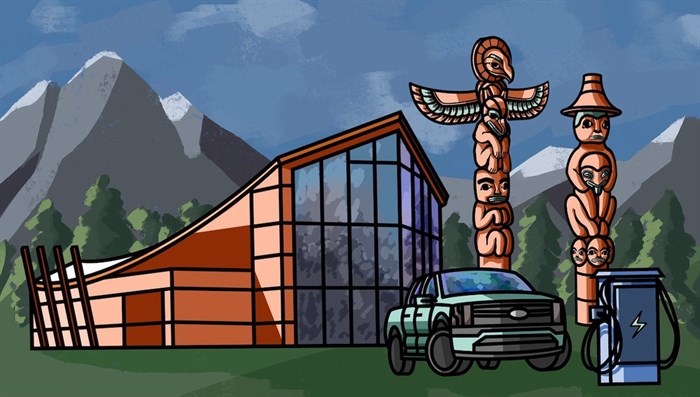
Rural, remote Indigenous communities face unique obstacles and need adapted solutions.
Image Credit: Illustration by Nyah Drew Murphy / Indigenous Clean Energy Charge Up program
November 23, 2023 - 9:30 AM
Paving the way to an Indigenous electric highway in Canada offers opportunities, but also includes navigating communities’ unique needs and potential obstacles, especially in rural and remote areas, experts say.
Indigenous communities are well aware of the economic development and revenue opportunities tied to electric charging infrastructure, like boosting tourism, economic development and green jobs with the transition away from fossil fuels, said Jessica Tait, co-ordinator of Indigenous Clean Energy’s (ICE) Charge Up program.
Shifting to sustainable transportation also meshes with many communities’ core principles.
“Many Indigenous groups have environmental goals that align with their traditional cultural values,” Tait said. “EVs can be part of their goal to reduce emissions, reduce noise pollution, boost adoption and to continue to be leaders and stewards of the land, waters and air.”
However, rural or remote Indigenous communities often face additional roadblocks compared to urban areas. They include extreme cold, difficult road conditions, greater upfront costs, limited electrical grids, spotty or non-existent Internet and less access to EV vehicles and the associated hardware, expertise and services to set up charging infrastructure, she said.
Crafting practical, adapted solutions to each area's challenges requires more imagination but is not unworkable, Tait stressed, noting one Indigenous off-grid community has a project using solar energy paired with battery storage to set up an EV charger.
Canada has a mandatory target for all car and passenger truck sales to be zero-emission by 2035. To ensure enough charging stations will be in place to support that target, Natural Resources Canada's $680-million Zero Emission Vehicle Infrastructure Program (ZEVIP) aims to have 84,500 chargers and 45 hydrogen stations in place by 2029.
However, while the ZEVIP program is on pace to exceed its 2026 target, building nearly 34,000 chargers as of July, Natural Resources Canada (NRCan) hasn’t prioritized or set targets for underserved areas like rural, remote and northern areas of Canada, a recent federal audit showed.
“Natural Resources Canada did not do enough to ensure the equitable distribution of charging stations across Canada,” the audit by Canada's Environment and Sustainable Development Commissioner Jerry DeMarco said.
The vast majority — 87 per cent — of the funded chargers were built in Ontario, Quebec and British Columbia.
The remaining 13 per cent were spread across the remaining provinces, the Northwest Territories and Yukon. Most were installed in multi-unit residential buildings and public places.
No funding applications came from Nunavut, the audit noted — likely because many of the territory’s communities are off-grid, and like others across Canada, are often reliant on diesel generators for electrical needs.
As of April, NRCan has launched a continuous-intake funding stream for Indigenous charger projects and increased the eligible cost subsidy to 75 per cent from 50 per cent, the report noted. It includes a target to increase Indigenous-led projects by five per cent each program year.
Charge Up has received $1.6 million in funding to distribute to Indigenous communities or groups across Canada that can apply for up to 75 per cent of eligible costs for either Level 2 or Level 3 fast chargers, Tait said.
Level 2 chargers are for longer stops of up to 12 hours and are well-suited for businesses that can charge overnight or workplaces and homes, Tait said, while the more expensive fast chargers are best located for quicker stops to meet long-distance travel needs.
It’s also possible to stack ICE’s funding with other provincial or regional programs to further increase the contribution amount for an Indigenous charger project, she said.
The sales of electric vehicles are surging in Canada, reaching 8.2 per cent in 2022, up from less than three per cent in 2019. In B.C., zero-emission vehicle sales reached 18 per cent in 2022, the highest in Canada, according to the province’s annual ZEV report.
At the end of 2022, there were over 3,800 public charging stations in B.C., with a target of 10,000 public charging stations by 2030.
However, the province also has significant gaps in its network, particularly in Indigenous, rural areas like north Vancouver Island, the North Coast, the Interior and northern B.C.
B.C.’s Go Electric program offers increased rebates for Indigenous communities and businesses, with up to 75 per cent of the eligible cost for chargers at homes, workplaces and for vehicle fleets.
For public fast chargers, Indigenous applicants can qualify for 90 per cent of the cost up to $130,000 per station.
Pilot projects that might involve renewables, battery storage, off-grid solutions or other innovative charging applications to overcome challenges faced by rural communities may be funded if they have a public benefit.
There are a mix of good charger programs that exist for Indigenous applicants, Tait said.
“It’s a bit of a double-edged sword but it can also be confusing to know which one might be the best fit.”
And there are lots of opportunities to build partnerships to deliver charging stations in Indigenous communities.
But it’s important for communities to determine what kind of chargers or projects are best suited to their needs and social and economic goals, and the Charge Up project can help deliver that, Tait said.
While broader infrastructure programs do have funding streams for Indigenous communities, they are not specifically designed by and for those communities, Tait noted.
For example, funding programs often require significant capital investments, with reimbursement coming after the fact, which can be an obstacle for small, remote communities.
“In general, the fact that programs require upfront funding is also a challenge. These are expensive projects,” she said.
“Moving away from Indigenous [components] in a broader program and towards funding programs that are specifically for Indigenous people and groups would be helpful.”
— This story was originally published by Canada's National Observer.
News from © iNFOnews, 2023